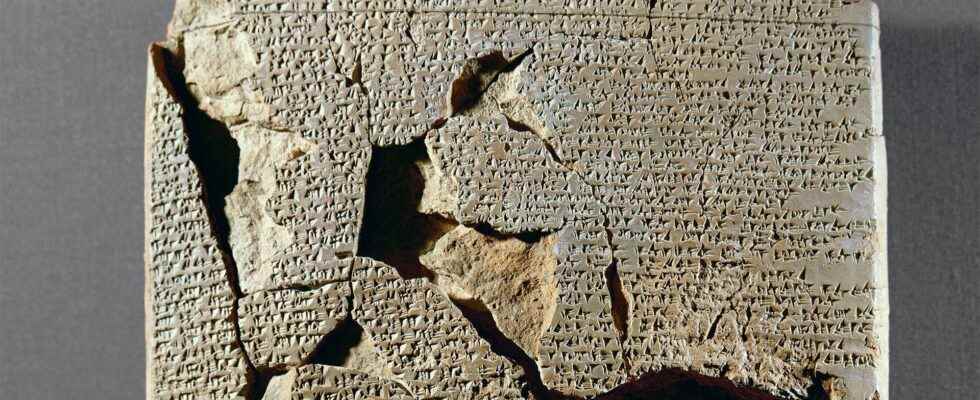Their successors, the pharaohs Amenhotep I and Thutmose I, wanted to ensure once and for all that princes from the Middle East would never again ascend the Egyptian throne, and carried out several campaigns in the Levant. Thutmosis even came to the upper Euphrates, where he erected a victory stele. One of his successors, Thutmosis III, defeated at the Battle of Megiddo in 1457 BC. a coalition of 330 Near Eastern kings and princes. However, part of his land gains were lost again under a strengthened Mitanni empire.
Egyptian version | On a wall in the Temple of Karnak the text of the peace treaty is depicted in hieroglyphs.
The two pharaohs that followed focused on their own country. The second, Amenhotep IV, who reigned from 1352 to 1336 B.C. When he was in power around 300 BC, he soon called himself Akhenaten and, together with his wife Nefertiti, introduced a new religion in which everything revolved around the worship of the sun disk Aten. He moved his capital to Tell el-Amarna in central Egypt, 400 kilometers north of Thebes. A letter from the Hittite king Šuppiluliuma I to the pharaoh was found among the 25,000 clay tablets in the throne archive there.
The Anatolian ruler took advantage of Akhenaten’s inaction in foreign policy. He recaptured the territories in Syria that had fallen to Mitanni. He remained in friendly diplomatic contact with the pharaoh. It might have stayed that way if Akhenaten’s successor Tutankhamun had not suddenly launched an attack on Kadesh, which was now under Hittite control. This act of aggression did not go unanswered. Šuppiluliuma I launched a counterattack and almost wiped out the Egyptian troops in Amka province.
The king’s dowager asked the Hittite ruler for a husband
Shortly thereafter, a letter reached the Hittite king. It was probably written by the widow of Tutankhamun, who died at a young age. In it, the childless regent asked that Suppiluliuma should send one of his sons as a bridegroom. It is true that dynastic marriages were not uncommon in the Middle East of the Late Bronze Age. As a rule, however, the parents arranged such marriages for their daughters. The whole story would be considered unbelievable if it had not been documented in detail in the Ḫattuša clay tablet archive by Šuppiluliumas I’s son. Understandably suspicious, the ruler hesitated and first sent his confidante Ḫattuša-Ziti to the Egyptian court as a scout. After spending the winter on the Nile, he returned to Ḫattuša in the spring together with the Egyptian ambassador Hani. Both assured Suppiluliuma that the dowager’s offer was sincere.
The king then sent his youngest son Zannanza to Egypt. But the prince died on the journey. Although the exact circumstances of his death were not known, the Hittite king blamed Egypt for his fate. If the two countries had already been deeply enemies after Tutankhamun’s advance, they were now in an open state of war. In retaliation, the heir to the throne, Arnuwanda, advanced into Egyptian territory and took thousands of prisoners of war to Hatti. The Hittites fought bitterly with the successors of Tutankhamun for the Syrian provinces. If the pharaohs conquered a city or region, the Hittites brought it back into their sphere of influence shortly afterwards.
The Battle of Kadesh
The showdown of the superpowers took place in 1274 BC. at the Battle of Kadesh. Here Muwatalli II, the grandson of Suppiluliuma I, and Ramses II faced each other. The Egyptians had 20,000 soldiers and 2,000 chariots. The force employed by the Hittite king, according to some sources, amounted to twice that. With a squad of scouts and four divisions, the pharaoh advanced towards Kadesh. When the Egyptians pitched their camp south of the fortress, two Bedouins came to Ramses’ tent. They posed as deserters from the Hittite army and reported that the Hittites had retreated north for fear of a military conflict. The inexperienced pharaoh was particularly fond of the idea of an enemy fleeing from the Egyptians. It fitted perfectly into the Egyptian royal ideology, which assumed a fundamental superiority of the rulers, as Francis Breyer, Egyptologist at the University of Bonn, convincingly portrays in his book Egypt and Anatolia.
